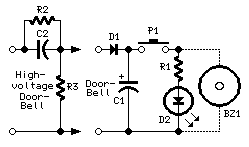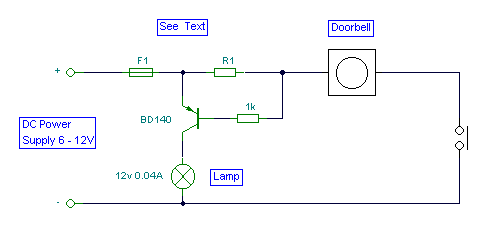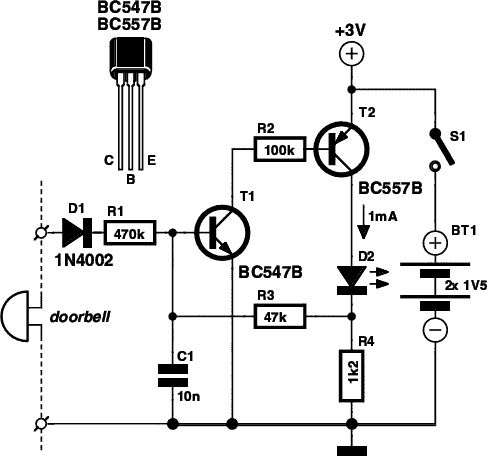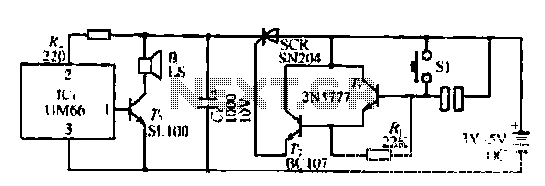
Doorbell for the Deaf
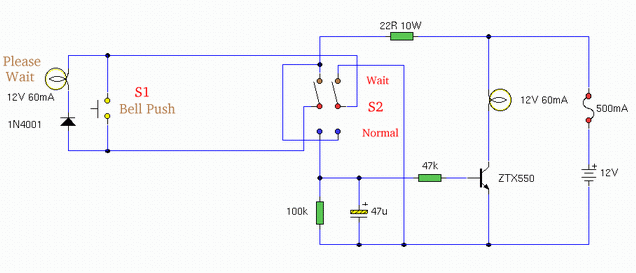
Doorbell for the Deaf. Circuit: Andy Collinson Email: [email protected]. This circuit provides a delayed visual indication when a doorbell switch is activated.
The doorbell circuit designed for the deaf serves as a crucial tool for providing visual alerts in response to doorbell activations. This circuit incorporates a delayed visual indication feature, which ensures that the alert is not only immediate but also sustained for a brief period, allowing individuals to notice it easily.
The core components of this circuit typically include a doorbell switch, a timer circuit, and a visual indicator, such as an LED or a series of LEDs. When the doorbell switch is pressed, it sends a signal to the timer circuit, which then activates the visual indicator. The timer is set to maintain the LED illumination for a predetermined duration, ensuring that the alert remains visible even if the individual is not immediately present at the door.
The circuit may utilize a 555 timer IC, which is widely used for timing applications. The configuration can be set up in a monostable mode, where the output remains high for a specific time interval after the doorbell switch is engaged. The time delay can be adjusted by changing the resistor and capacitor values connected to the timer IC.
Power supply considerations for this circuit are also important. It can be powered by a standard AC or DC source, depending on the specific design requirements. Proper voltage regulation and component ratings should be observed to ensure reliability and safety.
In summary, this doorbell circuit for the deaf not only enhances accessibility but also provides a practical solution for individuals who may not hear traditional doorbell sounds, ensuring they receive timely notifications of visitors.Doorbell for the Deaf. Circuit : Andy Collinson Email: [email protected] This circuit provides a delayed visual indication when a door bell switch is. 🔗 External reference
The doorbell circuit designed for the deaf serves as a crucial tool for providing visual alerts in response to doorbell activations. This circuit incorporates a delayed visual indication feature, which ensures that the alert is not only immediate but also sustained for a brief period, allowing individuals to notice it easily.
The core components of this circuit typically include a doorbell switch, a timer circuit, and a visual indicator, such as an LED or a series of LEDs. When the doorbell switch is pressed, it sends a signal to the timer circuit, which then activates the visual indicator. The timer is set to maintain the LED illumination for a predetermined duration, ensuring that the alert remains visible even if the individual is not immediately present at the door.
The circuit may utilize a 555 timer IC, which is widely used for timing applications. The configuration can be set up in a monostable mode, where the output remains high for a specific time interval after the doorbell switch is engaged. The time delay can be adjusted by changing the resistor and capacitor values connected to the timer IC.
Power supply considerations for this circuit are also important. It can be powered by a standard AC or DC source, depending on the specific design requirements. Proper voltage regulation and component ratings should be observed to ensure reliability and safety.
In summary, this doorbell circuit for the deaf not only enhances accessibility but also provides a practical solution for individuals who may not hear traditional doorbell sounds, ensuring they receive timely notifications of visitors.Doorbell for the Deaf. Circuit : Andy Collinson Email: [email protected] This circuit provides a delayed visual indication when a door bell switch is. 🔗 External reference
